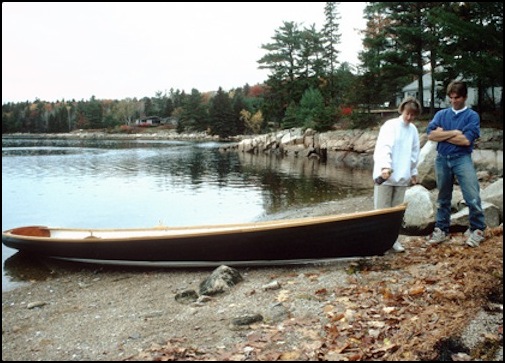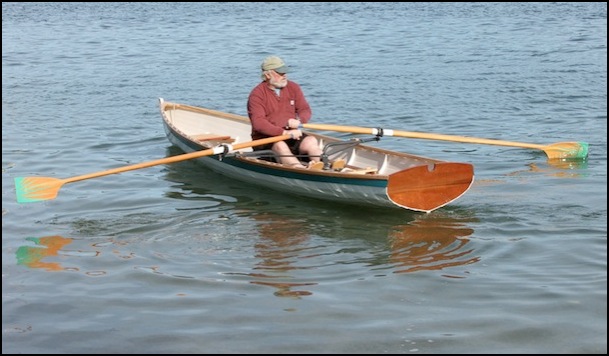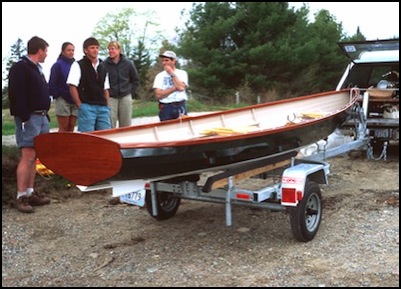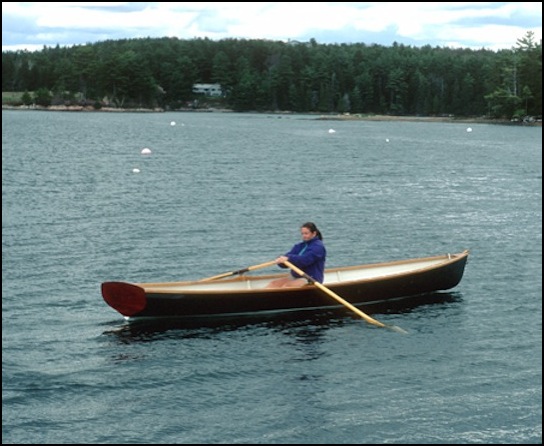Peregrine 18 rowboat
The Peregrine can be set up to row single or double, and/or be adapted to take a sliding seat rig. She is very fast, seaworthy, stable, and capable of carrying people and picnic gear or going all-out in a race. We’ve had folks build Peregrines for serious exercise and/or racing; touring, picnicking, and leisurely long rows; taking the kids along while mom and dad get some exercise; and also for fishing, since standing up in the boat to cast works very well.
Built with 4mm sapele plywood planking, a typical Peregrine weighs about 110 pounds; a boat built of high quality meranti marine plywood would weigh a bit less. One rower, never mind two, can easily put her up to hull speed and beyond; she begins to get up on plane and sets up a nice little rooster tail. When you ask her to, this boat goes.
In 1993, our friend Peter was looking for a light fast rowboat that he could use for getting plenty of fine exercise on open, but moderately enclosed, coastal Maine waters. His boat, the first Peregrine, was launched the following year. She was named Petit Pest, after Peter’s wife, who is indeed petite (and likes her nickname!). . .and who thought at first that she would not be able to row the boat, since she was not at all confident on the water and not terribly strong. She was surprised indeed on launching day; by the end of the day she was rowing around with a seriously wide smile. She rowed the boat often after that, and Peter enjoyed the ride.
Peter talked to us about rowing on an outing with some friends who were in kayaks, noting that the kayaks had to work to keep up while Peter rowed at a leisurely pace. “I get a lot of glide out of that boat.” He had an appointment to keep and when he started rowing at normal speed he said he quickly lost sight of the kayakers. He also told us about another occasion when he was out rowing in a fifteen-knot wind with a healthy chop and plenty of white caps. He said that he covered three miles in a roughly triangular pattern in 35 minutes. That’s an average speed of over five knots or a speed/length ratio of 1.27, nearly hull speed. He was “real impressed with how well his boat did going into the wind.” With a big grin, he reported that the downwind run was fast, adding “I had no problem navigating the course I wanted to go; control in the boat is incredible.” We asked him how the boat did when rowed across wind and sea, if he ever shipped some water when rolling—or worse. He told us that he never had gotten close to flipping the boat, explaining that he once stood up in the boat and rocked it to see how far it would go. It’s hard to get the rail near the water!” He then related an incident where he got waked by “a big stinkpot.” He turned the Peregrine into the large steep waves of the wake and to his surprise found that the boat handled so well that he rowed like crazy to catch up with the other half of the wake to surf it. He said the look on the face of the stinkpot boat driver’s face was priceless.
Another Peregrine owner who built his own boat wrote us a letter several months after the launching, saying, “Eight-foot spoon blade oars make her go great! Fast as h---!”
To read WoodenBoat’s review of the Peregrine (issue 126, page 98), go here to download issue 126 from the WoodenBoat archives. Note: It is a design review piece and although the search engine does not find “Peregrine” the article is in this issue.
The Peregrine can be set for fixed or sliding seat, or both.
Above: Peregrine set up by with a Piantedosi Row-Wing.
(This boat is currently for sale, for more information,
please contact the builder: Joe Thompson, Salt Pond Rowing.)
Below: Peregrine set up for fixed, with a carved contoured rowing seat.

length overall: 18'2""
drawn waterline: 16' 6"
beam, molded: 48"
depth (keel to sheer): 15"
• rowing: single or double;
fixed, sliding seat possible
• small outboard possible
• very comfortable for two adults, plus small child(ren), dogs, supplies and gear
• typical hull weight, 110 lbs. (rowing)
More photos
Sources and suppliers




